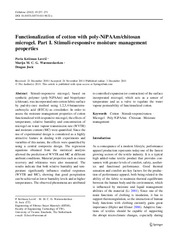Functionalization of cotton with poly-NiPAAm/chitosan microgel. Part I. Stimuli-responsive moisture management properties
Апстракт
Stimuli-responsive microgel, based on synthetic polymer (poly-NiPAAm) and biopolymer (chitosan), was incorporated onto cotton fabric surface by pad-dry-cure method using 1,2,3,4-butanetetracarboxylic acid (BTCA) as crosslinker. In order to assess the moisture management properties of cotton functionalized with responsive microgel, the effects of temperature, relative humidity and concentration of microgel on water vapour transmission rate (WVTR) and moisture content (MC) were quantified. Since the use of experimental design is considered as a highly attractive feature in dealing with experiments and variables of this nature, the effects were quantified by using a central composite design. The regression equations obtained from the statistical analysis allowed the prediction of WVTR and MC at different ambient conditions. Material properties such as crease recovery and whiteness were also measured. The results indicate that both relative humidity and temperature significantly influence ...studied responses (WVTR and MC), showing that good perspiration can be achieved at lower humidity levels and at higher temperatures. The observed phenomena are attributed to controlled expansion (or contraction) of the surface incorporated microgel, which acts as a sensor of temperature and as a valve to regulate the water vapour permeability of functionalized cotton.
Кључне речи:
Cotton / Stimuli-responsiveness / Microgel / Poly-NiPAAm / Chitosan / Moisture managementИзвор:
Cellulose, 2012, 19, 1, 257-271Издавач:
- Springer, Dordrecht
Финансирање / пројекти:
- ADVANBIOTEX [MEXT-CT-2006-042641]
- EUEuropean Union (EU)
DOI: 10.1007/s10570-011-9632-x
ISSN: 0969-0239
WoS: 000298994600024
Scopus: 2-s2.0-84855478193
Институција/група
Tehnološko-metalurški fakultetTY - JOUR AU - Lavrić, Pavla Krizman AU - Warmoeskerken, M. M. C. G. AU - Jocić, Dragan PY - 2012 UR - http://TechnoRep.tmf.bg.ac.rs/handle/123456789/2219 AB - Stimuli-responsive microgel, based on synthetic polymer (poly-NiPAAm) and biopolymer (chitosan), was incorporated onto cotton fabric surface by pad-dry-cure method using 1,2,3,4-butanetetracarboxylic acid (BTCA) as crosslinker. In order to assess the moisture management properties of cotton functionalized with responsive microgel, the effects of temperature, relative humidity and concentration of microgel on water vapour transmission rate (WVTR) and moisture content (MC) were quantified. Since the use of experimental design is considered as a highly attractive feature in dealing with experiments and variables of this nature, the effects were quantified by using a central composite design. The regression equations obtained from the statistical analysis allowed the prediction of WVTR and MC at different ambient conditions. Material properties such as crease recovery and whiteness were also measured. The results indicate that both relative humidity and temperature significantly influence studied responses (WVTR and MC), showing that good perspiration can be achieved at lower humidity levels and at higher temperatures. The observed phenomena are attributed to controlled expansion (or contraction) of the surface incorporated microgel, which acts as a sensor of temperature and as a valve to regulate the water vapour permeability of functionalized cotton. PB - Springer, Dordrecht T2 - Cellulose T1 - Functionalization of cotton with poly-NiPAAm/chitosan microgel. Part I. Stimuli-responsive moisture management properties EP - 271 IS - 1 SP - 257 VL - 19 DO - 10.1007/s10570-011-9632-x ER -
@article{
author = "Lavrić, Pavla Krizman and Warmoeskerken, M. M. C. G. and Jocić, Dragan",
year = "2012",
abstract = "Stimuli-responsive microgel, based on synthetic polymer (poly-NiPAAm) and biopolymer (chitosan), was incorporated onto cotton fabric surface by pad-dry-cure method using 1,2,3,4-butanetetracarboxylic acid (BTCA) as crosslinker. In order to assess the moisture management properties of cotton functionalized with responsive microgel, the effects of temperature, relative humidity and concentration of microgel on water vapour transmission rate (WVTR) and moisture content (MC) were quantified. Since the use of experimental design is considered as a highly attractive feature in dealing with experiments and variables of this nature, the effects were quantified by using a central composite design. The regression equations obtained from the statistical analysis allowed the prediction of WVTR and MC at different ambient conditions. Material properties such as crease recovery and whiteness were also measured. The results indicate that both relative humidity and temperature significantly influence studied responses (WVTR and MC), showing that good perspiration can be achieved at lower humidity levels and at higher temperatures. The observed phenomena are attributed to controlled expansion (or contraction) of the surface incorporated microgel, which acts as a sensor of temperature and as a valve to regulate the water vapour permeability of functionalized cotton.",
publisher = "Springer, Dordrecht",
journal = "Cellulose",
title = "Functionalization of cotton with poly-NiPAAm/chitosan microgel. Part I. Stimuli-responsive moisture management properties",
pages = "271-257",
number = "1",
volume = "19",
doi = "10.1007/s10570-011-9632-x"
}
Lavrić, P. K., Warmoeskerken, M. M. C. G.,& Jocić, D.. (2012). Functionalization of cotton with poly-NiPAAm/chitosan microgel. Part I. Stimuli-responsive moisture management properties. in Cellulose Springer, Dordrecht., 19(1), 257-271. https://doi.org/10.1007/s10570-011-9632-x
Lavrić PK, Warmoeskerken MMCG, Jocić D. Functionalization of cotton with poly-NiPAAm/chitosan microgel. Part I. Stimuli-responsive moisture management properties. in Cellulose. 2012;19(1):257-271. doi:10.1007/s10570-011-9632-x .
Lavrić, Pavla Krizman, Warmoeskerken, M. M. C. G., Jocić, Dragan, "Functionalization of cotton with poly-NiPAAm/chitosan microgel. Part I. Stimuli-responsive moisture management properties" in Cellulose, 19, no. 1 (2012):257-271, https://doi.org/10.1007/s10570-011-9632-x . .



